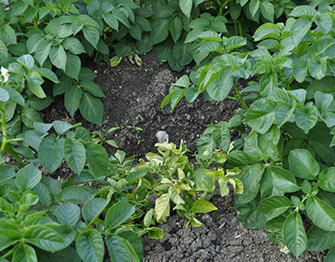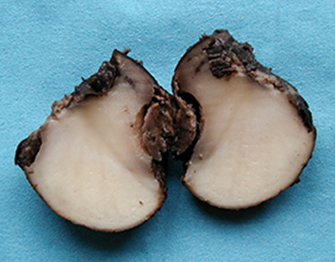Please click here to access the main AHDB website and other sectors.
- Home
- Knowledge library
- Blackleg and bacterial soft rot symptoms in potatoes
Blackleg and bacterial soft rot symptoms in potatoes
Blackleg is a major disease across all sectors of the potato industry in Great Britain causing non-emergence and stunting in the field. It is caused by several related bacteria that also cause soft rotting in tubers, sometimes devastating stored crops. The presence of rots results in the downgrading or rejection of seed, ware and processing crops. Even after successful storage, washing and pre-packing can inoculate and incubate tubers, leading to tuber breakdown in the supermarket.
Symptoms
Haulm
Early attack may cause non-emergence or stunted, pale-green to yellow foliage, the upper leaves may be rolled, the stems black and often greasy in the region at ground level. The stems are easily pulled out of the soil. Late attack may cause collapse of fully developed haulm. Infection with blackleg-causing bacteria can be distinguished from leaf roll or stem canker (caused by Rhizoctonia solani) by the presence of blackened stems at ground level or blackened soft pith in dissected stems.
There are several related bacteria that can cause blackleg and soft rots. Plants with blackleg caused by Pectobacterium atrosepticum (Pba) often have yellowish foliage and have a wilted appearance. Stems become blackened and sticky at ground level.
When Pectobacterium carotovorum enters the haulm through wounds and natural openings in leaves and stems it can result in above ground blackleg symptoms (aerial blackleg). Visible symptoms appear above soil level as a slimy green-brown rot (less dark than the rot caused by Pba) which in time can result in the collapse of a stem.
Dickeya species can cause the plant to wilt, with the plant often taking on a bluish appearance. The stems have a brownish, sticky discolouration and the vascular tissues are stained light brown.
Visual symptoms alone do not necessarily identify the pathogen involved and blackleg symptoms can vary according to the prevailing weather conditions, irrespective of the species of bacterium causing the disease.

Blackleg symptoms in a potato plant
Tubers
In tubers, the rot can start from infected wounds, lenticels and stolon ends. Symptoms of soft rot typically include soft, wet, cream-colored tissues. Diseased tissue is sharply demarcated from healthy tissue and sometimes has darker margins. It has little odour early on but will develop a foul smell as secondary organisms grow in the rot. The bacteria might also be present without any obvious symptoms (latent infection) until suitable conditions for disease development occur.

Soft rot in potato tubers

